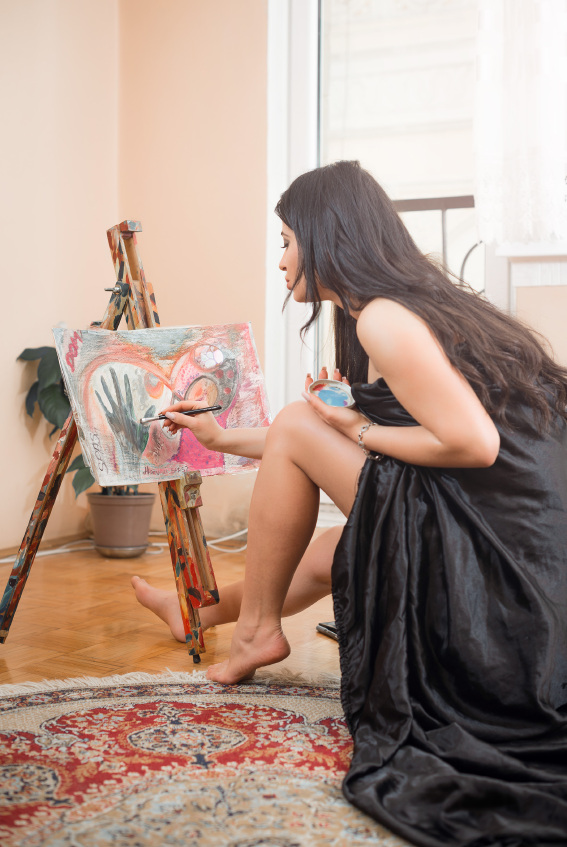
(This content is being used for illustrative purposes only; any person depicted in the content is a model)
Author: Shernide Delva
When pain is too hard to put into words, art may be the language you need to overcome that barrier. In addiction treatment, often art therapy is utilized as a form of expression. After an addiction, it can be difficult to communicate the struggle, trauma and emotional distress you had to overcome. Many treatment programs have found that art therapy can be an excellent tool of expression in the recovery process. When used in conjunction with other therapies, it can be a very powerful tool in a holistic program.
Using art as therapy is not anything new. In fact, the practice goes back to the 1940s, where a number of professionals first developed and recognized art as a therapeutic practice. Edward Adamson of Britain had a more laid back approach to art therapy. He would give clients art supplies and be uninvolved with the results, allowing the clients to find themselves on their own. On the other hand, Dr. Edith Kramer engaged with clients and helped them interpret meaning from their artwork. Today, art therapy is recognized and accepted as a respected form of psychotherapy. It can be found in a wide range of clinical settings including mental health centers, prisons, grief counseling and drug rehab programs.
What is Art Therapy?
The American Art Therapy Association (AATA) defines art therapy as:
“The therapeutic use of art making, within a professional relationship, by people who experience illness, trauma or challenges in living, and by people who seek personal development.”
Essentially, art therapy focuses on a client’s thoughts and emotions with the goal of developing self-expression rather than focusing on a set of art skills. You do not have to be the next Michelangelo to involve yourself in art therapy. In fact, in recovery, art can become a new form of communication and self-reflection for anyone. When other forms of communications fail, like talk therapy or counseling, art can be an excellent way to make an important emotional breakthrough, build trust, and gain self-worth.
Ways Art Helps in Addiction:
- Helps in visualizing the recovery process
- Opens mind to negative and positive feelings in recovery
- Allows the ability to visualize changes in your own life
- Provides a method of dealing with emotions in a positive way
- Promotes long term recovery
With all that in mind, there are different mediums used in art therapy. There is of course painting, but anything from doll making to road drawing and even music therapy can be used as a form of expression. Therapist use art therapy in a wide spectrum of ways. Here are a four cool examples of how art therapy is a successful addiction treatment tool.
- Doll making
The process of doll making can be very helpful in recovery. Patients are given a blank doll and slowly build the doll with their counselor or psychologist. Overtime, the patient will begin to see and internalize the doll as their own life. Just like the doll changes, life is constantly molding and changes. By doll making, patients begin to identify the doll as their own selves in recovery. Just like doll making, addiction recovery involves a person going through many stages of growth and finally becoming a whole person. - Road Drawing
Drawing or painting roads on a page can be another very therapeutic form of expression. The goal is to have patients see their own life as the road ahead of them. The way you draw the road can relate to how you see yourself. Therapist assist patients in analyzing the road and use it as a point of reference to discuss life situations. Therapist gain information about their past and even their intent for the future therapy. Overtime, the road drawn by a patient can begins to vary dramatically. - Altered Book
Altered book therapy allows patients to connect more with their emotions and can reduce the risk of a relapse. As an avid reader, this medium definitely sparked my interest. An old book is given to a patient and they are allowed to alter the existing book using a variety of materials. The process allows patients to connect with emotions not accessible through talk therapy. The objective is to teach patients that just like they can alter a book that already exists; they can also alter their own lives. Generating new meanings and new stories helps them solve their own dilemmas. - Music Therapy
Music therapy is a very commonly known form of art therapy. Music reduces stress, releases happy chemicals in the brain, and helps addicts deal with emotions. Music therapy is helpful for recovering addicts because music can help a person understand how they truly feel. Faster beats can help improve concentration while soothing beats help with relaxation. Drumming has been found to be especially helpful for patients dealing with pain or emotional trauma.
We all know addiction to drugs and alcohol is a huge problem. Alcohol is the leading cause of death in the United States. Every 15 minutes, someone dies from an opiate-related overdose. The average age for the first substance use is 13. Due to these and other startling stats, drug and alcohol treatment programs should be tailored to include as many necessary tools to help those suffering to break their destructive habits. Art therapy is example of a tool that can be healing and beneficial in addiction treatment.
Art therapy is a powerful and creative tool in recovery. If you are having trouble expressing yourself, perhaps art therapy could help you to communicate. Remember, addiction can affect anyone, so you should not be ashamed if you feel you are going down the wrong path. If you or someone you love is struggling with substance abuse or addiction, please call toll-free 1-800-951-6135.